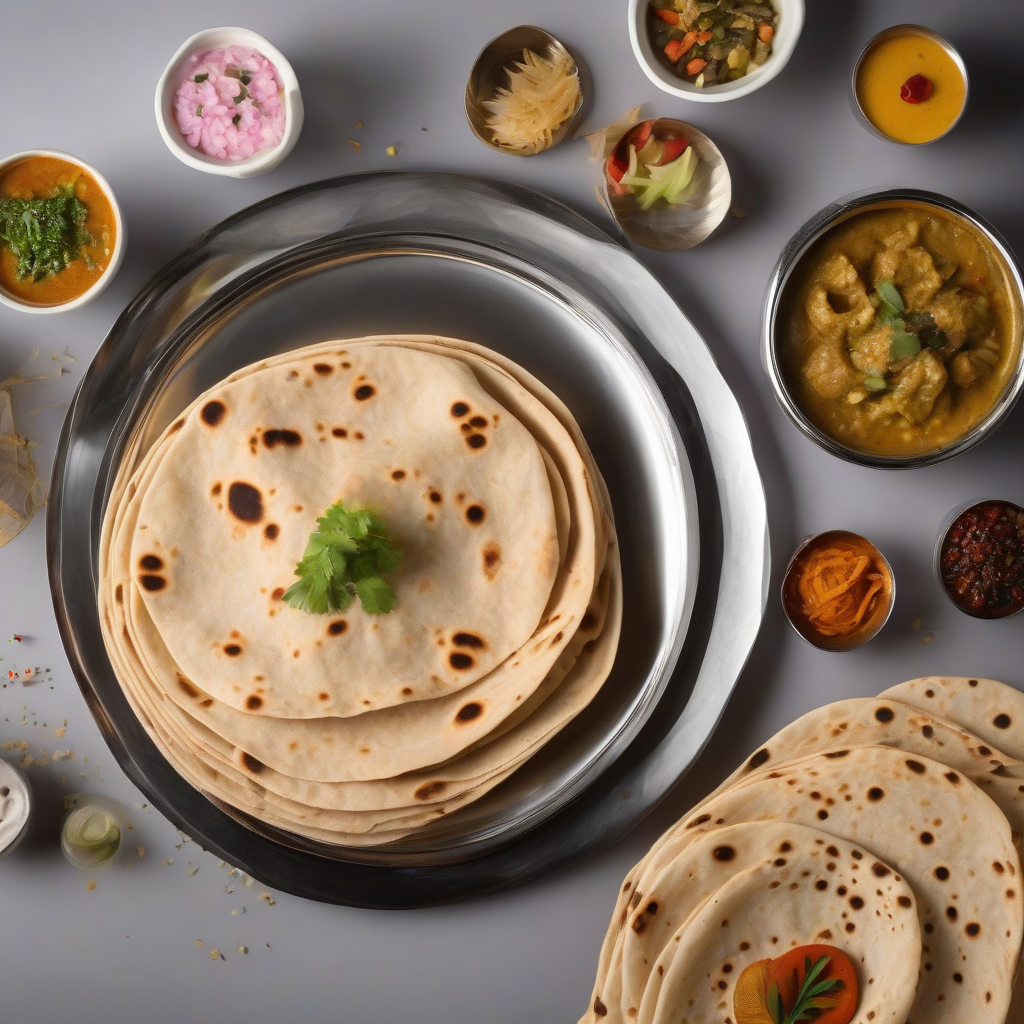Chapati Champions: Ghar Ghar Ki Roti! (A Taste of Home in Every Bite!)
Namaste Doston! Sat Sri Akal! Kem Cho? Chef Curry Do’pyaza here, back in your kitchens and ready to share another gem from the heart of Indian cuisine! Today, we’re talking about a dish so fundamental, so ubiquitous, it’s practically synonymous with Indian food itself: Chapati!
Think of Chapati as the humble hero of our meals. It’s the blank canvas that holds your favorite dal, the comforting companion to spicy sabzis, and the perfect vehicle for scooping up that last bit of delicious gravy. It’s the taste of home, no matter where you are.
Occasions for Chapati Love:
Chapati is truly an everyday staple in many Indian homes. You will find it on the table for breakfast, lunch, and dinner. But it also shines during special occasions! Think of Diwali, Holi, or even just a simple family gathering. It’s the reliable friend you can always count on. During the holy month of Ramadan, it’s often part of Iftar meals. And let’s not forget those long train journeys – a stack of chapati with some achar is the ultimate travel companion!
A Little Chapati History:
Chapati’s history stretches back centuries. It is believed to have originated in the Indian subcontinent, possibly even predating recorded history! It’s a testament to the ingenuity of our ancestors, who figured out how to make delicious and nutritious food from simple ingredients. This flatbread has nourished generations.
Ready to Roll? (Preparation & Cooking Times)
- Preparation Time: 15 minutes
- Cooking Time: 2-3 minutes per chapati
The Magic Ingredients (Samagri):
- 2 cups Gehun ka Atta (Whole Wheat Flour)
- 1 cup Pani (Water), lukewarm
- 1 teaspoon Tel (Oil) or Ghee (Clarified Butter)
- Pinch of Namak (Salt)
Let’s Get Cooking! (Vidhi):
- Mix it Up: In a large bowl, take your Gehun ka Atta. Add a pinch of Namak. Slowly add the Pani, mixing with your hands until a soft, pliable dough forms. The dough should be smooth and elastic.
- Knead Your Heart Out: Knead the dough for about 5-7 minutes. This is important! Kneading develops the gluten, which makes the chapati soft. Add a teaspoon of Tel or Ghee towards the end for extra softness.
- Rest and Relax: Cover the dough with a damp cloth and let it rest for at least 30 minutes. This allows the gluten to relax, resulting in softer chapatis.
- Divide and Conquer: Divide the dough into small, equal-sized balls. About the size of a golf ball is good.
- Roll with It: On a lightly floured surface (use Atta!), roll each ball into a thin, circular shape. Aim for a diameter of about 6-7 inches. Don’t worry if they’re not perfectly round – rustic is beautiful!
- Tava Time: Heat a Tawa (griddle) over medium-high heat. Place the rolled-out chapati on the hot Tawa.
- Cook One Side: Cook for about 30-45 seconds, or until small bubbles start to appear on the surface.
- Flip It!: Flip the chapati and cook the other side for another 30-45 seconds.
- The Puff: Now, this is the fun part! Either directly on the flame of your gas stove (using tongs!), or on the hot Tawa, gently press the chapati with a clean cloth or spatula. This will cause it to puff up like a balloon!
- Butter Up (Optional): Brush the hot chapati with a little Ghee or butter for extra flavor and softness.
Chef Curry’s Chapati Tips:
- The Dough is Key: The quality of your dough determines the quality of your chapati. Don’t be afraid to get your hands dirty and knead it well!
- Resting is Essential: Don’t skip the resting period. It makes a world of difference.
- Hot Tawa is a Must: Make sure your Tawa is hot before you start cooking.
- Don’t Overcook: Overcooked chapatis become hard and brittle.
- Practice Makes Perfect: Don’t get discouraged if your first few chapatis aren’t perfect. Keep practicing, and you’ll be a chapati champion in no time!
Different Ways to Cook Your Chapati:
- Gas Stove: The traditional method, using a Tawa and then puffing it up over the flame.
- Induction Stove: Works just like a gas stove, but with precise temperature control.
- Pressure Cooker: You can cook chapatis directly on the inverted base of a pressure cooker (without the lid).
- Oven: Preheat your oven to 350°F (175°C). Place the rolled-out chapatis on a baking sheet and bake for 2-3 minutes per side.
- Microwave: Not ideal, but you can warm up already cooked chapatis in the microwave for a few seconds.
- Air Fryer: Place the rolled-out chapati in the air fryer basket and cook at 350°F (175°C) for 2-3 minutes per side.
- Crockpot/Slow Cooker: Not recommended for cooking chapatis.
Nutritional Nuggets:
Chapati is a good source of carbohydrates, fiber, and iron. It provides sustained energy and helps with digestion. It’s a healthy and wholesome addition to any meal.
Serving Suggestions:
- Dal and Chapati: The classic combination!
- Sabzi and Chapati: Pair it with your favorite vegetable dish.
- Chicken Curry and Chapati: A match made in heaven!
- Achar and Chapati: A simple and satisfying snack.
- Roll-Ups: Fill it with leftover sabzi or Chicken for a quick and easy meal.
The Final Flourish:
There you have it, folks! The simple yet satisfying art of making chapati. It’s more than just a flatbread; it’s a connection to our culture, our heritage, and our loved ones.
Now, go forth and try this recipe! Share the warmth and deliciousness of homemade chapati with your friends and family. Trust me, they’ll thank you for it.
Until next time, happy cooking!
Chef Curry Do’pyaza, signing off!
